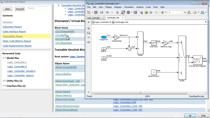Integrate TensorFlow Model into Simulink for Simulation and Code Generation
Watch a quick demonstration of how to use a pretrained TensorFlow™ network in Simulink® to implement a deep learning-based, state-of-charge estimation algorithm for a battery management system.
This demo uses a neural network that has been trained in TensorFlow using battery discharge data measured in the lab.
The example has two parts: importing a pretrained TensorFlow model into MATLAB® and using the imported model in Simulink for simulation and library-free C code generation. The first part shows how to use the importTensorFlowNetwork command to bring a neural network into MATLAB from TensorFlow and how to visualize an imported network in Deep Network Designer.
The second part illustrates how to put an imported network into a Simulink model using Predict block. Using this block, the network is simulated and results are compared with the true state-of-charge level as well as an estimate obtained using an extended Kalman Filter. Finally, the imported network is used to generate library-free C code that can run on any microcontroller or ECU, including the NXP S32K boards.
Published: 4 Apr 2022





